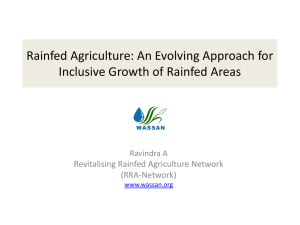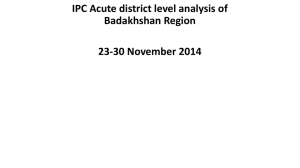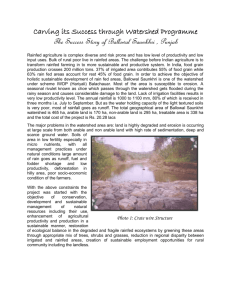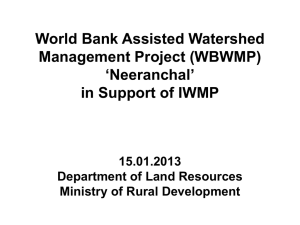The Role of Green Water in Food Trade
advertisement
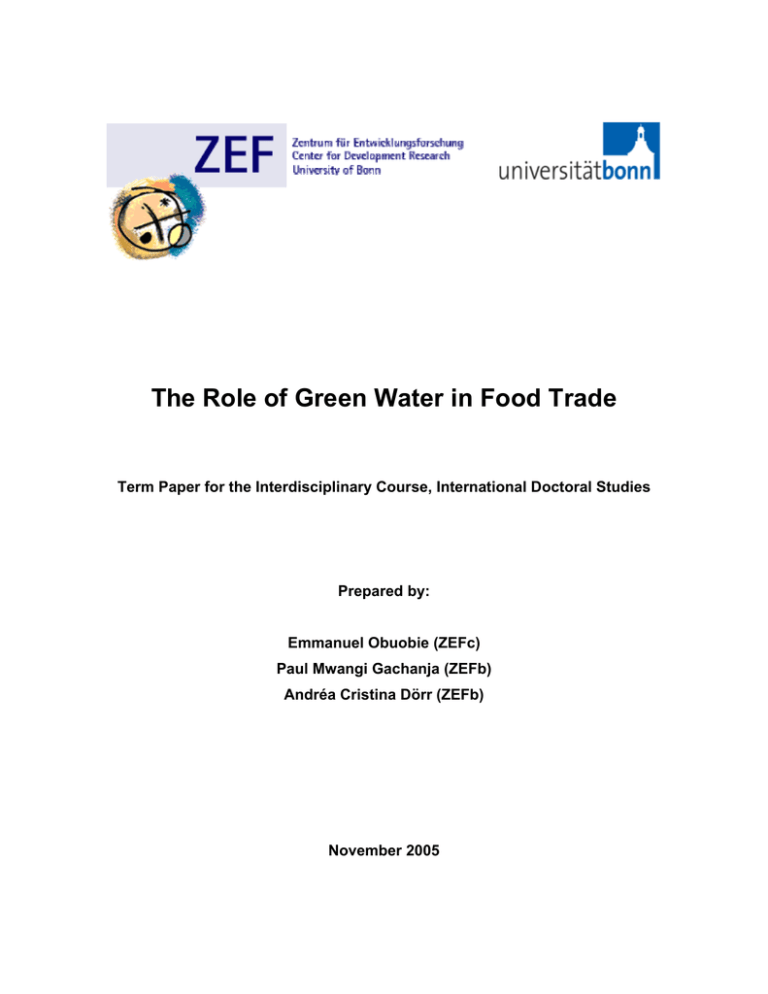
The Role of Green Water in Food Trade Term Paper for the Interdisciplinary Course, International Doctoral Studies Prepared by: Emmanuel Obuobie (ZEFc) Paul Mwangi Gachanja (ZEFb) Andréa Cristina Dörr (ZEFb) November 2005 Abstract The role of green water in food production and food trade cannot be over emphasized. Over 60 percent of the world food production is by green water and almost 80 percent of the agricultural land is in use by rain fed production systems. Food is the most basic necessity of life required by all humanity to lead healthy and productive lives, besides water. Over 800 million people do not have access to sufficient food and feeding a world population of 9 billion by the year 2050 is a long-term challenge which implies enormous increased pressure on the world’s finite water resources. Food trade can be considered a certain reallocation of water on a global basis. Through food trade, the variety and availability of food is no longer restricted by the diversity of locally grown foods or the limitations of the local growing seasons. Food trade improves entitlements through exchange hence widening the range of food available for consumption. With trade of food products, there is a virtual flow of water from producing and exporting countries to countries that consume and import those products. Therefore, food trade is basically trade with water as a commodity, referred to as virtual water. While different regions in the world are differently endowed with water resources, and while different food crops have different water intensities, food trade brings a water balance between the regions and every region is better-off specializing in producing food crops where it has a comparative advantage. China as highlighted in this study is a good case in point. Although China’s policy emphasizes on grain self-sufficiency, the country still imported as much as 17 percent of the worlds traded wheat, 28 percent of its soybeans oil, while exporting as much as 10 percent of the world’s traded maize. With the inland and coastal fisheries being threatened by more intensive withdrawal from blue water resources and with the increasing demand for food all over the world, the productive utilization of green water presents a window of opportunity. i TABLE OF CONTENTS ABSTRACT ............................................................................................................................i TABLE OF CONTENTS .......................................................................................................ii LIST OF TABLES ................................................................................................................iii LIST OF FIGURES ...............................................................................................................iv 1. INTRODUCTION .......................................................................................................... 1 2. DEFINITIONS AND CONCEPTS ................................................................................ 3 2.1 2.2 2.3 3. GREEN WATER IN GLOBAL FOOD PRODUCTION .............................................. 7 3.1 3.2 3.2 4. Green and blue water.............................................................................................. 3 Virtual water ........................................................................................................... 4 Food trade ............................................................................................................... 6 Merits of use of green water over blue water in food production .......................... 7 Current trend of green water based food production.............................................. 8 Green water potential in future food production .................................................... 8 VIRTUAL WATER AND GLOBAL FOOD TRADE ................................................ 11 4.1 4.2 Global virtual water flow...................................................................................... 11 Limitation of virtual water trade........................................................................... 14 5. CASE STUDY: CHINA............................................................................................... 15 6. CONCLUSIONS .......................................................................................................... 17 REFERENCES ..................................................................................................................... 18 ii LIST OF TABLES Table 1: Global virtual water trade: top 10 crop products (1995-1999)…….………12 Table 2: Top 10 virtual exporting and importing countries (1995-1999)…………...13 iii LIST OF FIGURES Figure 1: The three components of rainwater at basin level…………….………….…4 Figure 2: Water requirement for future food production….……………………….….9 Figure 3: Virtual water trade balances of thirteen world regions (1995-1999)…..…..13 iv 1. INTRODUCTION Besides water, food is the most basic necessity of life required by all humanity to lead healthy and productive lives. Currently there are about 852 million food-insecure people in the world. This includes 815 million people in developing countries, 28 million in transition countries and 9 million in developed countries (FAO, 2005). Poor people mostly in developing countries have to spend the largest proportion of their income on buying food or are not able to buy enough and remain hungry and undernourished. With projected increase in world population to about 7.8 billion people by the year 2025, the situation of food insecurity may increase, particularly in the developing world where more than 80 percent of the population increase is expected to occur (Rosegrant et al, 2002). This calls for not only striving to produce enough food to achieve food sufficiency but also ensuring that all people at all times have both physical and economic access to the basic food they need. Producing food requires water and can be done either as irrigated agriculture or rainfed. Irrigated agriculture has been an important contributor to the expansion of national and world food supplies since the 1960s, and is expected to play a major role in feeding the growing world population (Rosegrant et al, 2002). However, the possibilities of further extension seem to be limited since water resources of sufficient quality is increasingly becoming scarce or too expensive to use as a result of the growing competition from none agricultural sectors. Rainfed agriculture is currently predominant in the world. Almost 80 percent of the agricultural land is in use by rainfed production systems, providing 60 percent of the world food production (Stroosnijder, 2003; Savenije, 1998). Such significant levels of food production from rainfed agricultural systems emphasize the importance of green water as a resource for global food production. 1 As population grows and the demand for food increases, the need for food production grows. This means that more water is required to produce the extra food needed to feed the growing population. However, the quantity of water that is available for food production is largely limited by geographic location. While temperate areas like Europe and North America have abundant water resources, particularly green water to produce more food, arid and semi-arid areas like Africa and the Middle East can be described as water scarce areas because of the limited water resources. Such natural variation in water resources has resulted in situations whereby food is produced in excess of what is needed in some countries while others are not able to feed themselves. Direct transportation of water from water-rich countries to water-poor countries, with the view of bridging the water gap is almost impossible due to the cost as well as the distances involved. However, this is indirectly being done through food trade. This paper discusses the role that green water plays in global food production and food trade. The paper proceeds in chapter 2, with definitions and concepts of green water, blue water and virtual water and discusses the usefulness of these concepts in water management in food production and food trade. Chapter 3 addresses the role of green water in global food production, focusing on the current and future trends in green water use for food production. The flow of green water, through food trade, between exporters and importers of food crops is discussed in chapter 4. Chapter 4 ends by shedding light on some limitations inherent in virtual water trade. Chapter 5 presents a selected case study of China. China was selected based on her position in water resources endowment and how that shapes the food patterns of production and trade. Chapter 6 presents the conclusion of the term paper. 2 2. DEFINITION AND CONCEPTS The concepts of virtual water, green water and blue water have dominated recent discussions on water management in food production and food trade. These concepts have been considered as effective strategies for efficient water resources management, especially for countries where water is scarce. 2.1 Green and Blue Water The concept of green water was first introduced by Falkenmark (1995) to distinguish it from blue water and to better assess the role of water in agricultural production in subhumid and semi-arid regions. Since then this concept has been used by other authors (Savenije, 1999; 2000; Döll, 2002). Green water has been defined by Döll (2002) as the fraction of water that is evapotranspirated, that is, the water supply for all non-irrigated vegetation. Green water can be called either productive with respect to plant production if transpirated by crops or natural vegetation or non-productive if evaporated from soil and open water. With rainfed agriculture, vegetation relies only on green water in the process of evapotranspiration but in irrigated agriculture, vegetation sometimes relies on green water in addition to blue water. Blue water refers to the water flows in groundwater and surface water (river, lakes) (Ringersma, 2003). It represents the water that can be withdrawn for irrigation, drinking or industrial use or water that is available for in-situ water use like navigation. Figure 1 below is a schematic representation of green and blue water. Comparatively, green water is a significant water resource, much larger (volume-wise) than blue water. SIWI, IFPRI, IUCN, IWMI (2005) put the global average annual precipitation figure at 110,000 km3 of which around one-third reaches the aquifers, rivers and lakes (blue water) but only about 12,000 km3 is considered readily available for human use. The remaining two-third form soil moisture or returns to the atmosphere as consumptive water 3 use through evaporation from wet soil and transpiration from plants (green water). Besides its availability in large volumes, green water as a resource has a higher priority in food production at the global scale as many blue water resources such as rivers and lakes are already depleted beyond what is acceptable for downstream fisheries and coastal life. A more intensive withdrawal from blue water resources will further threaten inland and coastal fisheries. Fig. 1. The three components of rainwater at basin level (SIWI, IFPRI, IUCN, IWMI, 2005) 2.2 Virtual Water The concept of virtual water was first introduced by Allan (1997) to describe the fact that water-scarce countries could mitigate water shortage problems by importing food from other countries in the international food market rather than producing the required food with their own scarce water resources, which could be used for other useful purposes. Allan (1997) defines virtual water as the volume of water required to produce a commodity or service. Virtual water is sometimes referred to as the ultra-violet water or the invisible water (Savenije, 2000). From food production point of view, the concept of virtual water is used to express the amount of water used in the process of producing food and therefore 4 contained in a food product. The production of a kilogram of cereal requires 1-2 m3 of water depending on the efficiency of the production process and it takes about 10 m3 of water to produce a kilogram of beef (Wang, 2004). Therefore, the virtual water value, defined as the volume of water required to produce one unit quantity of food is about 1-2 m3/kg for grain and for beef, it is about 10 m3/kg. With the trade of food products, there is a virtual flow of water from producing and exporting countries to countries that consume and import those products. In other words, trading in food products is virtually a kind of water re-allocation. Van Hofwegen (2004) observed that virtual water trade is already a silent alternative for most water-scarce countries and that the growing interest in virtual water does not only come from the fact that it could be used as an instrument to achieve water security in water-poor regions but also because of its increasing importance for food security in many countries experiencing a continuous expansion of their population. The value of virtual water differs for different foods and may differ even for the same food in different production sites considering the various climatic conditions. To produce 1 ton of maize takes about 900 m3 of water in China. However, it takes only 400 m3 in France (Renault, 2003). In other words, to transport 1 ton of maize makes 400 m3 of virtual water in France becomes 900 m3 of virtual water in China. To import 1 ton of maize from France to China, regionally, 900 m3 of water is saved in China; globally, 500 m3 of water is saved considering the different virtual water value in these two production sites (China, 20031). Food trade from the countries with low virtual water value to the countries with high virtual water value leads to a higher water use efficiency at the global scale. Food production can take place in rainfed agricultural systems in which case rain water is the only source of water for food production or in irrigated an agricultural system which uses water from surface water sources and aquifers but also rainwater if the system happens 1 This paper does not have the name of the Author(s) on it. We have provided the internet link to the paper in the reference section. 5 to be supplemental irrigation. Therefore, virtual water comprises two parts: green water and blue water. 2.3 Food Trade In simple terms, food trade can be defined as the exchange of food products, either crops or meat and livestock. Food can be traded at the domestic level (home trade) or at the international (global) level involving imports and exports of food products among countries. Through food trade, the variety and availability of food is no longer restricted by the diversity of locally grown food or the limitations of the local growing season. Between 1961 and 1999 there has been a 400 percent increase in worldwide food exports. Some countries are now economically dependent on food exports, which in some cases account for over 80 percent of all exports (www.answers.com). Food trade improves the physical and economic access to food by increasing food availability, which also contributes to lower food prices for domestic consumers. Food trade also promotes the international exchange of surplus food and agricultural products. In other words, it improves entitlements through exchange and, in so doing, widens the range of food available for consumption, improving diets and satisfying food preferences. In this paper, much of what is captured is food trade at the global scale that involves crop products (mainly cereals). 6 3. GREEN WATER IN GLOBAL FOOD PRODUCTION The role of water in food production cannot be over emphasised. All over the world, food production is know to be the most water consuming activity, accounting for over 80 percent of the global total fresh water withdrawal (FAO, 2005). Water is now the number one food production limiting factor in many parts of the world. Since the Green Revolution in the 1960s, the role of water in food production has been associated with blue water to the neglect of green water (SIWI, IFPRI, IUCN, IWMI, 2005) 3.1 Merits of Use of Green Water over Blue Water in Food Production In comparison to blue water, green water is the larger component of fresh water and is responsible for the larger part of the world's food and biomass production and trade. The environmental impact associated with green water use is relatively minor because it does not change the hydrological systems. In contrast, the opportunity cost of the use of blue water in agriculture is high since blue water has many other functions and requires facilities for storage and distribution. The environmental impact of such water use can be significant due to the changes such use can make in the natural courses of water flows. For example, excessive irrigation can cause severe salinization, water logging and soil degradation, which are evident in many areas of the world (Wang, 2004). Another merit of green water use over blue water is that, green water based food production is less costly considering the heavy capital (machinery, irrigation infrastructure, energy etc) and labour investments used to divert blue water from lakes, rivers or aquifers to the fields. Therefore, exporting green virtual water through food trade is overall more efficient than exporting blue virtual water; the virtual water exported from the ten largest food exporting countries in the world is mainly green water. 7 3.2 Current Trend of Green Water Based Food Production Globally, food consumption patterns are changing rapidly and hence the increased need for enhanced food production. Recent studies have recognized the important role of green water in food production. Green water is a very important resource for food production for by far it is responsible for about 60 percent of the world staple food production. The entire meat production from grazing relies on green water. In Sub-Saharan Africa, almost the entire food production depends on green water (the relative importance of irrigation is minor) (Savenije, 2000). The largest food exporting countries are those that have rain-fed agriculture with vast plains where adequate and reliable rainfall is available, such as America, Canada and Northern and Central Europe. In terms of agricultural production system, Rosegrant et al (2001) found that 69 percent of all cereal area is rainfed, including 40 percent of rice, 66 percent of wheat, 82 percent of maize and 86 percent of other coarse grains. More than 80 percent of cereal area in developed countries is rainfed, much of which is highly productive maize and wheat land such as that in the Midwestern United States and parts of Europe. 3.2 Green Water Potential in Future Food Production The potential for green water based food production is enormous although it is probably the most under-valued resource of all water resources and often not featured on the water agenda. It is increasingly becoming clear that irrigation will not be able to provide the food needed to feed the escalating world population. When comparing 2050 food needs with projected increase of water required for producing such food, given feasible development of irrigated agriculture (max. 14 percent of the 2050 needs) and improved efficiency of rainfed agriculture (can cover another 30 percent), there still remains the challenge of additional need of water (SIWI, IFPRI, IUCN, IWMI, 2005). This could only come from green water resources either through horizontal expansion or from turning evaporation into transpiration (See Figure 2). 8 Food production worldwide will continue to depend on green water and more so as competition for blue water for non agricultural uses increases. Agriculture in most developing countries, particularly Sub-Saharan Africa, almost entirely depends on green water and this dependency will grow as further development of irrigation systems is prohibitively expensive. In Asia, intensive blue water development for irrigation has resulted in situations where many basins have become closed to the point where all water is committed and additional withdrawals are impossible (SIWI, IFPRI, IUCN, IWMI, 2005). Therefore blue water is of limited interest when it comes to food self reliance in SubSaharan Africa and many parts of Asia. Experts have shown that when comparing future food needs with projected increase of food production, given feasible development of irrigated agriculture and global market, a hunger gap is being left over Sub-Saharan Africa and South Asia (Falkenmark, 2005). Green water offers a window of opportunity to close this gap. Fig. 2. Today’s food production involves a consumptive water use of altogether 6800 km3/yr (out of which 1800 are supplied from blue water resources). To feed humanity by 2050 on 3000 kcal per person per day will require an additional 5600 km3/yr, out of which a maximum of 800 will come from blue water resources. The 2050 column shows that the remaining 4800 have to be contributed from new green water resources (e.g. horizontal expansion) or from turning evaporation into transpiration (vapour shift). Source: SIWI, IFPRI, IUCN, IWMI (2005) 9 In spite of the great potential of green water, rainfed agriculture has been marginalised for various reasons including low productivity (See e.g., Savenije, 2000). Globally, 80 percent of the agricultural land is in use by rainfed production systems, which provides 60 percent of the world food production (Ringersma, 2003). In contrast, irrigated production systems occupy the remaining 20 percent and provide 40 percent of the world food production. Worldwide average yield of rainfed cereal (2.2 mt/ha), for example, is 65% of the irrigated yield (3.5 mt/ha); the yield is higher in developed countries (3.2 mt/ha) than developing countries (1.5 mt/ha) (Rosegrant, et al, 2001). While rainfed agriculture in the developed world has been highly mechanised and production is highly efficient, the same cannot be true of arid and semi-arid areas like sub-Saharan Africa where rainfed agriculture is practiced by small scale farmers at a subsistence level with a very low efficiency. Rainfall is unreliable in such areas and there are recurrent droughts which often lead to production failures. This has resulted in some disregard for the potential of rainfed agriculture to increase food production. However, Savenije (2000) and Ringersma (2003) have argued in favour of rainfed agriculture as having an enormous potential for increasing food production if given the scientific attention it deserves. 10 4. VIRTUAL WATER AND GLOBAL FOOD TRADE As discussed earlier on in part 2.2, virtual water has two components: green virtual water and blue virtual water, depending on the crop production system, either rainfed agriculture or irrigated agriculture. Nearlly all the available literature on global and in-country virtual water trade do not give clear indication of the proportion of green and blue virtual water used in production of the food traded. However, it is established beyond any doubt that green virtual water dominates the global virtual water trade (See eg., Wang, 2004; Renault, 2003; Hoekstra and Hung, 2002). For example, the virtual water exported from the ten largest virtual water exporting countries (see Table 1) in the world is predominantly green water since most of the food production in these countries is rainfed; almost all the exported virtual water associated with food trade in Canada is green water, the export of blue water is negligible (Wang, 2004). In Central Europe and Australia, green water contributes 90 percent of the total cereal production. Similar patterns are observed in South and Central America. In this part, virtual water implies green virtual water (for the reason mentioned above) though the figures strictly apply to virtual water. 4.1 Global Virtual Water Flow The global volume of crop-related virtual water trade between nations is estimated to be 695 Gm3/yr in average over the period 1995-1999, of which 67 percent relates to international trade of crops, 23 percent to trade of livestock and livestock products and 10 percent to trade of industrial products (Hoekstra and Hung, 2002). Crop products, especially cereals, take the largest share in the total virtual water trade, accounting for a little over 78 percent of the annual crop related virtual water. Wheat is the single largest contributor to the global virtual water export (30 percent of the total volume of crop-related virtual water export between 1995 and 1999), followed by soybeans (17 percent) and rice (15 percent) (see Table 2). 11 At the cntinental level, North America, South America and Oceania are the sources of virtual water (see figure 3). With regard to export, the USA, Canada, Thailand, Argentina, India, Australia, Vietnam, Guatemala and Brazil are the top ten exporters of virtual water, contributing over 80 percent of the total net virtual water export of the world through major crop commodities (cereals, edible oils and sugar) (Hoekstra, 2003). Wang (2004) found out that North America (United States and Canada) alone contributes nearly half of the global total virtual water export and the net exports of virtual water from the United States amount to one thirds of the total water withdrawal in the country. Table 1. Top 10 virtual exporting and importing countries (1995-1999) Exporters Importer Country Country Net Export volume Net Import Volume (109 m3) (109 m3) USA 758.3 Sri Lanka 428.5 Canada 272.5 Japan 297.4 Thailand 233.3 Netherlands 147.7 Argentina 226.3 Korea Republic 112.6 India 161.1 China 101.9 Australia 145.6 Indonesia 101.7 Vietnam 90.2 Spain 82.5 France 88.4 Egypt 80.2 Guatemala 71.7 Germany 67.9 Brazil 45 Italy 64.3 Source: Hoekstra and Hung (2002) Major destinations of virtual water are East Asia, Central America, Western Europe, North and West Africa and the Middle East, among them, East Asia is the largest virtual water importer, receiving over 30 percent of the total virtual water exported (Wang, 2004). The top ten importers of virtual water between 1995 and 1999 are listed in Table 2 with Sri Lanka and Japan leading. 12 Table 2. Global virtual water trade: top 10 crop products (1995-1999) Product % of the virtual water trade Wheat 30.20 Soyabean 17.07 Rice 15.36 Maize 8.85 Raw sugar 7.20 barley 4.88 Sunflower 2.71 Sorghum 2.01 Bananas 1.97 bananas 1.86 Source: Hoekstra and Hung (2002) Fig. 3. Virtual water trade balances of thirteen world regions over the period 1995-1999. The arrows show the largest net virtual water flows between regions (>100 Gm3). Source: Hoekstra and Hung (2002). 13 4.2 Limitation of Virtual Water Trade As already discussed in part 2.2 and 3.1, it is often cheaper and environmentally less destructive for many water scarce countries to import water intensive crops like cereals than to produce those crops locally with their limited water resources, which could be used for other activities that may be economically more rewarding. This could be a strategy for efficient water use. However, virtual water trade can have unfavourable consequaences for both the importing and exporting countries. The importing countries could become over dependant on the exporting countries which could result in importing countries comprising other more pressing concerns, like rural employment, political and social stability for efficient virtual water trade. And in situations where exporting countries are not able to produce enough to export, food security in importing countries could become threatened. For exporting countries, the increasing demand for food could exert pressure on them to produce beyond their green water capacity, resulting in further over exploitation of blue water. 14 5. CASE STUDY: CHINA China has become a focal country in world food security due to the huge population, the limited resources and the expanding economy. The water demand has traditionally been shared by three major sectors: agriculture, industry and domestic use. Agriculture is by far the largest water consumer in China, accounting for nearly 70 percent of the total water demand of about 560 Gm3/yr at least by 1999. Although the country ranks sixth in the world in terms of the available water resources, the large population of over 1.3 billion posses a big challenge both to water use and food production (World Bank, 2000). The water scarcity problem is primarily a food problem in China due to the fact agriculture consumes the largest amount of water resources and certainly, it is the only sector which consumes green water resources. However, in some cities (especially the cities in Huang, Huai and Hai river basins) the water supply in domestic and industrial sectors is still a problem. Self-sufficiency for food has been a basic Chinese agricultural policy since 1960s. China is known for its grain production with rice, maize and wheat being the major grains and others including barley, millet, potatoes, sorghum and soybeans. Its food policy is absolutely important for the global food security. Although China’s policy emphasizes on grain selfsufficiency, it still imported as much as 17 percent of the worlds traded wheat, 28 percent of its soybean oil, while exporting as much as 10 percent of the world’s traded maize (Carter and Rozell, 2001). Although irrigation (blue water) plays an important role in the food production in China, the green water resources have played even a greater role in the production of the main grains mentioned above. In as far as wheat is concerned, averagely, green water accounts for over 56.7 percent of the total wheat production. In the top five wheat production provinces, green water accounts for 83 , 32, 38, 78 and 76 percent in Henan, Shandong, Hebei, Jiangsu and Auhui provinces respectively. Generally speaking, green water 15 contributes more in the southern and northeastern parts of China and less in other regions. It accounts for more than 90 percent of the wheat production in Southeast Basin, Changjiang Basin and Yhujiang Basin because in these regions, the annual rainfall averagely exceed over 1200 mm/yr. However, green water only contributes to less than 40 percent in most regions in Huanghe Basin (China, 2003). Maize production also relies heavily on the green water resources. On the average, green water accounts for over 71 percent of the total maize production in China. About 90 percent of the maize produced in Sichuan, Xinjiang, Yunnan, Hainan, Guizhou, Henan and Zhejiang is attributed to green water resources, even though Henan is the major maize production site. Generally speaking, green water contributes greatly to the maize production in most regions of China except in some northern part of the Interior Basins, such as in Ningxia and Gansu Provinces, where green water only accounts for less than 30 percent of the maize due to the low rainfall and high evaporation (China, 2003). All in all, given the fact that China is one of the world’s most water deficient countries with such a huge population of over 1.3 billion including 70 percent of rural population, it has the comparative advantage in labour intensive agricultural products instead of the water intensive ones. Few grains, fruits and vegetables are categorized under low water intensive crops, most grains apart from maize (which falls under low water intensive ones) are medium water intensive and many cash crops are high water intensive. China policy should therefore encourage the fruit and vegetable export and promote the cash crop import considering its comparative advantage. For grain export, China has a long-term low water intensive maize export, which accounts for nearly 70 percent of the total grain export since 1985. For grain import, although wheat, a medium water intensive crop, played the most important role traditionally, the wheat imports have dropped dramatically since 1995 with a sharp rise in high water intensive soybean imports. During the period of 1992 to 2001, China has had an annual virtual water import of 52 Gm3/yr of which 30 Gm3/yr was green water and 22 Gm3/yr was blue water. The virtual water export of 11 Gm3/yr contained 7 Gm3/yr of green water and 4 Gm3/yr of blue water (China, 2003). 16 6. CONCLUSIONS The concepts of green water, blue water and virtual water are useful for effective management of water resource in food production. Green water is much more in abundance and currently responsible for more than half of the food produced in the world. Besides, the use of green water in food production is associated with little or no environmental hazard since green water use does not necessarily change the hydrological system. Food production is the most water intensive activity in the world and more water is required to produce the food needed to feed the increasing world population. The role of blue water in meeting the water need for food production is limited since in many areas blue water is already being over exploited and any further exploitation could result in ecological problems. But green water has the potential to meet the water requirement for future food production if the efficiency of rainfed agricultural systems is improved. In achieving this, aappropriate investments and policy reforms will be required. As water resources are unevenly distributed worldwide, with the result that some countries are rich in water whereas others are poor in water, food production is greatly constrained in water-scarce countries. These water-scarce countries can trade in virtual water with waterrich countries, through food trade, as a mean to solving the water scarce situation. And a larger proportion of virtual water is green water since food production from the major virtual water exporting countries is predominantly rainfed. Thus, green water is the backbone of food trade. Its productive use presents a window of opportunity that will address the emerging global food crises. 17 REFERENCES Allan, J.A. 1997. Virtual Water: a Long-Term Solution for Water Short Middle Eastern Economies? Paper presented at the 1997 British Association Festival of Sciences. University of Leeds, England. Carter, C.A., Rozlle, S. 2001. Will China´s Agricultural Trade Reflect its Comparative Advantage? China´s Food and Agriculture: Issues for the 21st Century, pp. 27-30. China, 2005. Virtual Water, Green Water and Blue Water in China. http://www.nideco.ethz.ch/news/past_events/colloquium_2003/Liu_Presentation.pdf. Döll, P. 2002. Water for Agriculture-A Global Systems Analysis Perspective. University of Kassel, Center for Environmental Systems Research, Germany. http://www.tropentag.de/2002/proceedings/node34.html. Falkenmark, M. 2005. Green Water: Conceptualising Water Consumed by Terrestrial Ecosystems. Global Water News. N. 02, August. Falkenmark, M. 1995. Coping with Water Scarcity under rapid Population growth. Conference of SADC Ministers, Pretoria, November, 23-24. FAO. 2005. Having the Number of Hungry in the World by 2015. Rome, Italy. http://www.fao.org/spfs FAO. 2005. International Trade and Food Safety and Quality, Rome, Italy. http://www.fao.org/es/esn/food/control_foodtrade_en_stm FAO. 2005. More crop per drop http://www.fao.org/english/newsroom/focus/2003/water.htm FAO. 2005. The importance of Food Quality and Safety for Developing Countries. Rome, Italy. http://www.fao.org/trade/docs/LDC-foodqual_en.htm FAO. 2005. Report of the High Level Round Table on Agricultural Trade Reform and Food Security. Rome, Italy. FAO. 2003. Trade Reforms and Food Security: Conceptualizing the Linkages. Commodities and Trade Division, Rome, Italy. 18 FAO. 2004. The State of Food Insecurity in the World: monitoring Progress towards the World Food Summit and Millenium Development Goals. 6 th ed. Rome, Italy. FAOSTAT. 2005. Statistics Database. http://www.fao.org/waicent/portal/statistics_en.asp Hoekstra, A. Y. 2003. Virtual water trade between nations: a global mechanism affecting regional water systems. UNESCO-IHE Institute for Water Education. Delft, Netherlands. Hoekstra, A.Y. and Hung, P.Q. 2002. Virtual Water Trade – a Qualification of Virtual Water Flows between Nations in Relation to International Crop Trade. Value of Water Resarch Report. Series n.11, IHE, Delft, the Netherlands. ICID. 2004. Paper on Global Issues Related to Food Production, Security and Trade. In: International Commission on Irrigation and Drainage 48, Nyaya Marg, Chanakiapury, New Delhi, 110-021, India. Open Directory Project. www.answers.com Ringersma, J. 2003. Optimizing green water use and improved crop water productivity under rainfed agriculture in Sub-Sahara Africa. ISRIC Abstract of a data search and literature study. http://www.isric.nl/Greenwater/Green%20water%20ABSTRACT.doc Renault, D., 2003.Value of Virtual Water in Food: Principles and Virtues. In Hoekstra A.Y. (Eds) 2003. Virtual Water Trade, Proceedings of the international expert meeting on virtual water trade, Delft, the Netherlands: pp77-91. Rosegrant, M., Cai, X., Cline, S., and Nakagawa, N. 2001. The Role of Rainfed Agriculture in the Future of Global Food Production. German Development Institute/ International Food Policy Research Institute. http://www.water-2001.de/supporting/Role_of_Rainfed_Agriculture.pdf Rosegrant, M., Cai, X., Cline, S., and Nakagawa, N. 2002. The Role of Rainfed Agriculture in the Future of Global Food Production. International Food Policy Research Institute. http://www.ifpri.org/divs/eptd/dp/eptdp90.htm Savenije, H.H.G. 1998. How to feed a growing World Population in a Situation of Water Scarcity? Key note paper presented at the 8th Stockholm Symposium, 10-13 August, 1998. In: Water: the Key to Socio-Economics Development and Quality of Life, pp. 4958, SIWI, Stockholm. 19 Savenije, H.H.G. 2000. The Role of Green Water in Food Production in Sub-Saharan Africa. Article prepared for FAO. IHE, Delft, The Netherlands. SIWI; IFRI; IUCN; IWMI. 2005. Let it Reign: the new Water Paradigm for Global Food Security. Final Report to CSD-13. Stockholm International Water Institute, Stockholm. Stroosnijder, L. 2003. Technologies for improving rainwater use efficiency in semi-arid Africa. In: D. Beukes, M. de Villiers, S. Mkhize, M. Sally, and L. van Rensburg (Eds). Proceedings Water Conservation Technologies for Sustainable Dry lands Agriculture in sub-Saharan Africa (WCT). Symposium and Workshop. P. 92-102. Bloemfontein, South Africa. 8-11 April 2003. Van Hofwegen, P. 2004. BBC Viewpoint: the water debate. http://news.bbc.co.uk/2/hi/science/nature/3752590.stm Von Braun, J.; Hanzell, P.; Hodddinot, J.; Babu, S. 2003. Achieving Long-Term Food Security in Southern Africa: International Perspectives, Investments Strategies and Lessons. In: Southern Africa Regional Conference on Agricultural Recovery, Trade and Long-Term Food Security. Gaborone, Botswana, March 26-27. Wang, H. 2004. Virtual Water Trade. The Canadian Magazine for Responsible Business. http://www.corporateknights.ca/content/page.asp?name=virtual_water_trade World Bank Group. 2005. Food Security. http://inweb18.worlbank.org/ESS/ardext.nsf/12ByDocName/KeyTopicsFoodSecurity World Bank Group. 2000. World Development Indicators 2000. http://www.worldbank.org. 20
